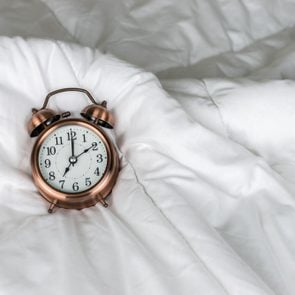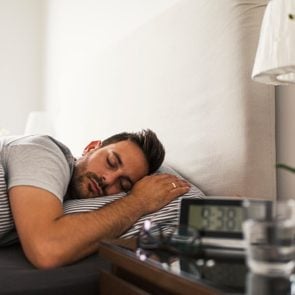What It’s Really Like to Have Narcolepsy
Updated: Jul. 29, 2020
For people with this chronic sleep disorder, there is no corner of life that narcolepsy hasn't touched. Julie Flygare's battle with the condition, which has caused extreme exhaustion and even hallucinations, began in college—and she hasn't stopped fighting since.
Our editors and experts handpick every product we feature. We may earn a commission from your purchases.

For 34-year-old Julie Flygare, memories of college are somewhat of a blur. The Los Angeles resident first attributed her sleepiness during classes to the boring subject matter, but when she found herself in the bathroom every hour to wash her face and pinch her cheeks to keep from falling asleep, she knew something was truly amiss. But she still didn’t realize that she had the diagnosable—not to mention dangerous—sleep disorder narcolepsy.
Slapping herself to stay awake
“It became a sort of schedule I kept,” Flygare says. “I couldn’t go to class early because the urge to sleep was so strong, so I began this habit of excusing myself to the bathroom repeatedly just to slap myself or splash water on my face so I could stay awake,” she says. Her symptoms of narcolepsy grew terrifying when she began hallucinating at age 21. “I was in a new apartment in Boston, and I awoke to a burglar breaking in. I felt paralyzed and couldn’t move, even though I was certain I was in danger,” she says. The burglar turned out to be a hallucination—one that would recur throughout the following years. (Read more about narcolepsy and 11 other sleep disorders.)
A seemingly unrelated symptom occurred soon after when she felt her knees begin to buckle beneath her while she was laughing at a joke. “I thought it was weird. I started telling my friends not to make me laugh so I wouldn’t collapse,” she recalls. Flygare made an appointment with her physician after she lost her grip on a glass she was holding while laughing at a party. “The doctor told me I needed to breathe deeper—that I was simply laughing too hard,” she says.
Flygare accepted the doctor’s advice but continued experiencing symptoms. Then she hit a breaking point: “I was making the ten-minute drive to law school for finals. I have no memory of anything else, but I woke up in the parking lot, with my seat reclined. I had no memory of parking or even pulling in the lot. That’s when it hit me that something wasn’t right,” she recalls. Flygare made another appointment with her physician and was told that her symptoms weren’t anything concerning. (Watch out for these 17 sneaky signs you need to see a sleep doctor.)
A knee injury leads to a diagnosis
It wasn’t until she had a session with a sports therapist for a knee injury that she heard the words that changed her life forever. “The sports therapist said, ‘I think I’ve heard of knee buckling—it’s called cataplexy,’” she recalls. Narcolepsy with cataplexy is a rare sleep disorder that is caused by a loss of the chemical hypocretin in the brain. People with the combo often experience loss of muscle tone that presents as slurred speech, a slack jaw, and limb weakness, and it is triggered by emotions like joy or anger. “I went home and read more about narcolepsy, and I knew that was what I was experiencing,” she says. (Learn about 10 sleep aids that are actually hurting your sleep.)
When Flygare sought a diagnosis from a neurologist, she underwent a 24-hour sleep study in which she also had opportunities to nap. “The neurologist told me that I went straight into the REM-sleep stage during naps, which is a classic sign of the disorder,” she recalls.
It’s been ten years since her diagnosis, and today Flygare says she still deals with the disorder daily. Treatment with Xyrem (sodium oxybate), a medication that treats both daytime drowsiness and cataplexy, has lessened her symptoms considerably. She also takes stimulants during the day. “Having narcolepsy affects every decision I make. It’s a lot of work to make it look effortless, but I’m constantly thinking about it when I make decisions,” she says.
Helping others with narcolepsy
Flygare is now leading the way for others who have the disorder. She has written a book about her experiences called Wide Awake and Dreaming: A Memoir of Narcolepsy; she is also president and CEO of Project Sleep, a foundation she created to educate and support others with narcoleptic symptoms. “I’m passionate about spreading awareness,” she says. “I’m proud to be a person with narcolepsy, and I want others with it to know they aren’t alone.” Make sure you are aware of the narcolepsy symptoms and treatments experts want you to know about.



